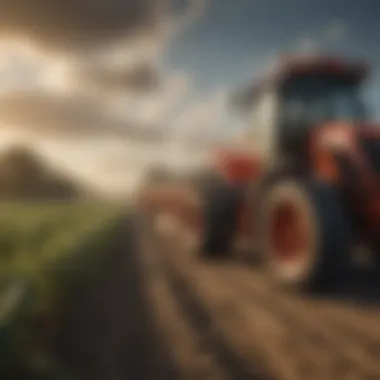Understanding Freight Distribution in Agriculture


Intro
Distribution freight is at the heart of agricultural practices, influencing the entire supply chain of this essential sector. Without an efficient distribution system, farmers struggle to move their goods from fields to markets. Understanding the intricacies of distribution freight is crucial for anyone involved in agriculture, from small-scale farmers to large agribusinesses. The growing importance of sustainability and efficiency places additional emphasis on these concepts.
Key Concepts and Terminology
Basic Definitions
Distribution freight refers to the process of transporting agricultural products from one location to another, typically from producers to consumers. This can include various modes of transportation such as trucks, trains, and ships. Key terms that often arise in this context include:
- Supply Chain: The sequence of processes involved in the production and distribution of a commodity.
- Logistics: The detailed coordination of complex operations involving people, facilities, and supplies.
- Freight Management: The process of overseeing and managing all aspects of transportation of goods.
Historical Context
Understanding the historical evolution of distribution freight helps contextualize its current impact. In early agricultural societies, goods were transported locally by simple methods. The industrial revolution introduced mechanization and improved transportation systems, leading to larger-scale distribution networks. In modern agriculture, globalization has further transformed distribution, making it possible to transport agricultural goods across vast distances.
Recent Innovations and Trends
Technological Advancements
Recent technological developments enhance distribution freight efficiency. Innovations such as GPS tracking and route optimization software allow for better planning of transportation routes. Additionally, blockchain technology increases transparency in the supply chain, making it easier for stakeholders to trace the origins of agricultural products.
Sustainable Practices
With the rising importance of sustainability, many agricultural stakeholders are adopting eco-friendly freight solutions. This includes using electric or hybrid vehicles, optimizing load capacity, and minimizing fuel consumption. Sustainable distribution practices are vital to reducing the carbon footprint of the agricultural sector.
"Efficient distribution freight not only impacts profit margins but also contributes significantly to environmental sustainability."
Practical Applications and Techniques
Step-by-step Guides
Understanding how to optimize distribution freight is beneficial. Key steps include:
- Assessing the Existing Supply Chain: Identify inefficiencies and areas for improvement.
- Implementing Technology: Use tools for route optimization and inventory management.
- Training Staff: Educate employees on best practices and new technologies in freight management.
- Monitoring and Adjusting: Continuously monitor performance and make necessary adjustments to ensure efficiency.
Case Studies
Exploring real-world examples highlights the importance of distribution freight. One notable case is the use of blockchain for tracking produce from farm to table. Companies like IBM have partnered with agricultural producers to create systems that improve transparency and efficiency, resulting in enhanced trust and lower waste.
Through understanding the multifaceted nature of distribution freight, stakeholders in the agricultural sector can improve their practices, enhance supply chain efficiency, and contribute toward more sustainable practices.
Prelude to Distribution Freight
Distribution freight serves as the backbone of the agricultural sector. This system is essential for the effective movement of goods from producers to consumers, impacting various aspects such as supply chain management and sustainability practices.
Understanding the nuances of distribution freight is vital for stakeholders in agriculture. Farmers, distributors, and retailers must grasp how distribution affects their operations and profitability. By examining distribution freight, we can uncover its benefits, challenges, and solutions that can enhance overall efficiency.
Definition of Distribution Freight
Distribution freight refers to the logistics involved in the movement of agricultural products from the point of production to the market. This process encompasses several activities, including transportation, storage, and inventory management. In simpler terms, it is the method through which goods are delivered to their final destination. The aim is to connect producers, retailers, and ultimately consumers while ensuring that products maintain their quality throughout the journey.
Historical Context
Historically, distribution freight in agriculture has evolved significantly. Early agricultural societies relied on basic methods such as horse-drawn carts and small boats to transport goods. As demand increased and technology progressed, methods of transportation transformed. The introduction of railroads in the 19th century allowed for faster and more efficient movement of goods.
Today, distribution freight includes advanced transportation networks relying on trucks, trains, ships, and planes. The role of technology has also expanded, incorporating tracking systems and data analytics. Improved distribution practices have not only affected the speed of delivery but also the cost-efficiency and sustainability of the agricultural supply chain. Understanding this historical context is essential for recognizing current trends and future developments in distribution freight.
The Role of Distribution Freight in Agriculture
Distribution freight is a linchpin within the agricultural sector, facilitating the direct connection between producers and consumers. Its significance extends beyond mere transportation; it encompasses how agricultural goods travel from the farms to the market shelves. Understanding this role not only sheds light on the complexities of agricultural logistics but also emphasizes the importance of an efficient distribution strategy.
Connecting Producers and Consumers
Effective distribution freight strengthens the relationship between producers and consumers. Farmers rely on robust distribution networks to ensure that their products reach the market quickly and in good condition.


- Direct Communication: A well-structured distribution system allows producers to have direct feedback from consumers. This interaction can help farmers refine their practices and meet market demand effectively.
- Market Access: Distribution freight opens more market avenues for producers, especially small-scale farmers. It enables them to reach consumers directly instead of relying solely on intermediaries.
- Freshness and Quality: Fast and efficient transportation ensures that agricultural products, especially perishables like fruits and vegetables, maintain their freshness and quality. This is crucial for consumer satisfaction and repeat business.
Overall, connecting producers and consumers through effective distribution practices is essential for the sustainability of agriculture and for keeping food prices competitive.
Enhancing Supply Chain Efficiency
Supply chain efficiency is a critical aspect of distribution freight in agriculture. The aim is to reduce unnecessary delays and costs while maximizing productivity.
- Reduced Transportation Costs: Efficient routing techniques minimize both distance and time, leading to lower transportation costs. This savings can be transferred back to the producer or consumer, benefiting everyone in the chain.
- Streamlined Inventory Management: Distribution freight involves timely delivery and storage solutions. By implementing advanced inventory systems that anticipate demand, producers can avoid overstocking or stockouts, preserving their financial resources.
- Technology Integration: With the rise of technology, farms can now utilize data analytics to predict trends and enhance their supply chains. This use of data improves the efficiency of distribution freight, allowing producers to adapt to consumer demands quickly.
In summary, enhancing supply chain efficiency not only benefits producers and consumers but also strengthens the agricultural economy as a whole. The role of distribution freight is thus indispensable, as it supports the intricate web of logistics that keeps agricultural products flowing.
Components of Distribution Freight
Distribution freight in agriculture is crucial for the effectiveness of moving goods from producers to consumers. The components of distribution freight include transportation methods, warehousing, and storage. Understanding these elements is vital to optimizing logistics and ensuring smooth operations within the agricultural supply chain. Each of these components plays a significant role in delivering products efficiently and sustainably, impacting the overall success of agricultural practices.
Transportation Methods
Transportation is the backbone of distribution freight. Each method serves specific needs and offers unique benefits depending on the type of goods being transported and the destination.
Road Transport
Road transport is a flexible method of freight distribution. It allows for door-to-door delivery, which is a significant advantage for reaching rural or remote areas. The key characteristic of road transport is its accessibility. Trucks can navigate various terrains and road conditions, making them a popular choice for farmers needing to deliver products locally.
A unique feature of this method is the ability to adjust routes easily. This adaptability can help in managing tight schedules and perishable goods like fruits and vegetables. However, road transport also has disadvantages, such as vulnerability to traffic congestion, which can lead to delays.
Rail Transport
Rail transport is efficient for moving large volumes of goods over long distances. The key characteristic here is its capacity. Trains can carry heavy loads, making them suitable for transporting bulk agricultural products like grains or fertilizers.
One notable advantage of rail transport is lower emissions compared to road transport, aligning with sustainability goals in agriculture. However, a drawback is limited access directly to farms or storage locations. This requires additional logistics, such as transferring goods to trucks for final delivery.
Marine Transport
Marine transport is pivotal when products need to cross oceans. The key characteristic of this method is cost-effectiveness for bulk shipments, especially for exporting agricultural products. Ships can carry significant amounts of goods like soybeans or corn to international markets.
A unique feature of marine transport is its long-distance reach, connecting producers with consumers across continents. However, the time involved in sea transport can be disadvantageous for perishable items. Moreover, weather conditions can affect shipping schedules.
Air Transport
Air transport is the fastest method for distributing agricultural products. The key characteristic here is speed, making it ideal for high-value or perishable items such as seafood or certain fruits.
A unique feature of air transport is its capability to cover long distances quickly, reducing the risk of spoilage. Despite these advantages, it tends to be the most expensive option, which can limit its use to premium products or urgent shipments.
Warehousing and Storage
Effective warehousing and storage are crucial in maintaining the quality and availability of agricultural products. Understanding the various types of warehousing, temperature control, and inventory management can significantly enhance logistics operations.
Types of Warehouses
The types of warehouses used for agricultural products vary according to specific needs. General warehouses serve multiple functions while specialized warehouses, like cold storage, are designed for perishable items. The key characteristic of warehouses is their role in consolidating shipments before distribution.
A unique feature of specialized warehouses is their ability to maintain the quality of stored goods, which is critical for food safety. However, they often come at a higher operational cost, considering the technology and upkeep needed.
Temperature Control
Temperature control is essential for the storage of perishable goods. It involves using refrigeration systems to stabilize conditions that prevent spoilage. The key characteristic of temperature control is its direct impact on the shelf life of products.
A notable feature of effective temperature control is the capability to adapt to different products' requirements. For example, fruits may require different temperatures compared to meats. However, implementing these systems can increase energy consumption and operational costs.
Inventory Management
Inventory management is crucial in maintaining an accurate record of stock levels. This practice ensures that products move efficiently through the supply chain. The key characteristic is real-time tracking of goods, which helps prevent overstocking or shortages.
A unique feature of advanced inventory management systems is their integration with technology to provide data analytics, allowing for informed decision-making. On the downside, such systems require proper training and can be costly to implement.


"Understanding the components of distribution freight is essential for improving efficiency and sustainability in agriculture."
Overall, each element of distribution freight contributes significantly to the agricultural supply chain. These components work together to enhance productivity while reducing costs and improving sustainability.
Challenges in Distribution Freight
Distribution freight in agriculture is not without its complications. Understanding these challenges is essential for stakeholders aiming to enhance efficiency and sustainability. High operational standards and compliance are paramount in ensuring products reach consumers in a timely and safe manner. From the regulatory landscape to logistical mysteries and unpredictable weather, the hurdles faced in distribution freight are many.
Regulatory Compliance
Regulatory compliance is crucial in agriculture distribution. Each product must adhere to safety standards set by various authorities. This can include food safety regulations, transportation standards, and local or international laws. Not only do these regulations ensure product safety, but they also protect the environment.
The key characteristic of regulatory compliance is its unpredictability. Regulations can vary widely across regions, which adds complexity to the distribution process. Failure to comply can result in severe penalties, delays, or loss of markets.
Understanding and navigating these regulations can affect the overall performance and reputation of agricultural businesses. It offers a chance to build trust with consumers who prioritize safe and sustainably sourced products, but the labyrinth of laws can represent a significant burden.
Logistical Hurdles
Logistical hurdles in distribution freight encompass various issues, primarily routing issues and traffic congestion. These factors can severely hamper the smooth operation necessary to deliver products efficiently.
Routing Issues
Routing issues are significant in the distribution process. The choice of routes can impact transport costs, delivery speeds, and product quality by reducing transit time. Each route presents unique challenges like tolls, road conditions, and regulations that may alter delivery schedules.
One major advantage of addressing routing issues is improved cost efficiency. By using sophisticated routing software, businesses can optimize their delivery networks. However, the challenge remains to keep the logistics team up-to-date with real-time information, which can be a resource-intensive endeavor. Good route management can minimize delays, thus ensuring fresh produce arrives in optimal condition.
Traffic Congestion
Traffic congestion poses a considerable problem in many regions. It can result in longer delivery times and increased fuel costs. The key characteristic of traffic congestion is its variability; congestion can depend on the time of day, weather, or even local events. Addressing this issue is essential for maintaining schedules and reducing operational costs.
While there are advantages to using established routes, traffic jams can lead to entire schedules being thrown off balance. This can, in turn, affect product freshness and lead to additional operational costs. Businesses must carefully monitor traffic patterns to mitigate these complications and find ways to adapt quickly.
Impact of Weather Conditions
Weather conditions play an unpredictable role in distribution freight. Natural elements can affect transportation methods, timing, and product integrity. Severe weather can cause delays in transportation, damage products, or even halt operations altogether.
Sun, rain, snow, and wind all have direct effects "on shipping schedules, making adaptability a requisite for successful distribution in agriculture." Understanding these risks can help stakeholders devise strategies to manage them better.
In summary, the challenges in distribution freight are multifaceted. Regulatory compliance, logistical hurdles, and weather uncertainty must all be considered. Addressing these challenges not only enhances efficiency but also strengthens the agricultural supply chain, ensuring products are delivered safely and on time.
Technological Innovations in Distribution Freight
Technological innovations are shaping the future of distribution freight in agriculture. The integration of advanced technologies has led to significant improvements in efficiency, cost reduction, and sustainability. Understanding how these innovations influence the agricultural supply chain is crucial for stakeholders aiming to enhance operations and ensure timely delivery of goods.
Automation in Logistics
Automation is transforming logistics processes within the agricultural sector. Automated systems streamline various tasks, from inventory management to route planning. By utilizing automated solutions, businesses reduce human error, which often leads to costly mistakes. Automated vehicles and drones are examples of how technology is improving transport efficiency. In warehousing, automation systems can manage stock levels and even handle packing and sorting of products.
The benefits are clear:
- Cost Savings: Reduced labor costs and increased speed of operations.
- Improved Accuracy: Minimizing errors in order fulfillment and inventory tracking.
- Scalability: Easier to adapt operations to increased demand.
Investing in automation technology thus presents a strong case for modern agricultural logistics.
Tracking and Monitoring Systems
Tracking and monitoring systems have become critical in enhancing visibility throughout the supply chain. With technologies like GPS and IoT devices, stakeholders can keep tabs on their shipments in real-time. These systems provide updates on location, temperature, and even humidity levels during transit. This is particularly important for perishable goods, where timely delivery is crucial.
The advantages include:
- Real-Time Data: Immediate access to information about cargo location and condition.
- Informed Decision-Making: Ability to adjust routes and manage delays efficiently.
- Enhanced Transparency: Building trust with consumers by ensuring goods are handled properly.
Implementing effective tracking systems can lead to enhanced operational performance in the agricultural sector.
Data Analytics for Growth


Data analytics is a powerful tool for driving growth in distribution freight. Agriculture businesses can analyze trends, monitor performance, and predict future demands by collecting and interpreting data. This enables them to make strategic decisions that can lead to improved efficiencies.
Some key aspects of data analytics in freight include:
- Demand Forecasting: Anticipating the needs of consumers based on historical data.
- Route Optimization: Using data to find the most efficient delivery paths, reducing fuel consumption.
- Performance Metrics: Tracking key performance indicators to enhance service levels and customer satisfaction.
By leveraging data analytics, agricultural stakeholders can gain a competitive edge in the rapidly evolving market.
Sustainability in Distribution Freight
Sustainability in distribution freight is critical in the agricultural sector. It reflects a commitment to environmental stewardship and social responsibility. With increasing awareness of climate change and resource depletion, the need for sustainable practices has never been more urgent. Distribution freight plays a significant role in determining how agricultural products are moved from farms to consumers. The emphasis on sustainability leads to numerous advantages, including reduced costs, improved public image, and compliance with regulations.
Reducing Carbon Footprint
One of the first steps towards sustainability is reducing the carbon footprint associated with distribution freight. Carbon footprint refers to the total greenhouse gas emissions produced directly or indirectly by transportation. The agricultural sector often involves long-distance hauling, which significantly contributes to emissions.
Specific methods can be adopted to minimize this impact:
- Efficient Routes: Optimizing delivery paths can reduce travel distance and time, leading to lower fuel consumption.
- Alternative Fuels: Utilizing biofuels or electric vehicles can drastically lower emissions compared to traditional diesel trucks.
- Load Optimization: Maximizing the load capacity of freight vehicles ensures more efficient transport, decreasing the number of trips required.
Reducing the carbon footprint not only addresses environmental concerns but also enhances the profitability of distribution operations. Companies that engage in sustainable practices often see cost savings due to lower fuel expenses.
"Sustainability is a continuous journey, not a destination."
Eco-Friendly Packaging Solutions
Another significant aspect of sustainability in distribution freight lies in the choice of packaging. Traditional packaging often contributes to environmental degradation. The agricultural sector can benefit from shifting towards more eco-friendly packaging solutions.
Considerations for eco-friendly packaging include:
- Biodegradable Materials: These alternatives break down naturally without leaving harmful residues in the environment.
- Recyclable Packaging: Offering packaging that can be reused or recycled promotes resource efficiency.
- Minimal Packaging: Reducing packaging materials not only lowers waste but can also cut costs associated with material purchase and transportation.
Farmers and distributors are encouraged to collaborate with suppliers that prioritize sustainable packaging materials. This partnership can lead to innovation and a noticeable reduction in environmental impact.
In summary, sustainability in distribution freight represents a vital investment in the future of agriculture. By focusing on reducing the carbon footprint and adopting eco-friendly packaging solutions, stakeholders can contribute to a more sustainable agricultural supply chain.
Future Trends in Distribution Freight
The landscape of distribution freight within the agricultural sector is rapidly evolving. Various factors are driving changes, such as advances in technology, shifting consumer preferences, and environmental concerns. Understanding these future trends is important for agricultural stakeholders who seek to enhance operational efficiency and remain competitive in an ever-changing market.
Shift Towards Digital Freight Platforms
The transition to digital freight platforms marks a significant trend in distribution freight. These platforms offer real-time data, streamlined communication, and improved transparency during transportation. By operating through applications and websites, they reduce manual tasks associated with logistics management.
The benefits of using digital freight platforms are numerous:
- Enhanced Efficiency: Automating scheduling and tracking saves time.
- Cost-Effectiveness: Reduced overhead costs from traditional logistics methods.
- Better Inventory Management: Access to real-time data enables improved decision-making.
Agriculture businesses can leverage these platforms to allocate resources better and minimize delays. Additionally, digital platforms can integrate various shipping methods, from trucking to shipping, into a single interface, simplifying the user experience. Overall, this shift promotes agility and resilience, crucial for adapting to changing market demands.
Rising Demand for Local Sourcing
Another significant trend is the increasing demand for local sourcing in agriculture. As consumers become more aware of sustainability and the carbon footprint of transporting goods over long distances, they prefer locally sourced products.
Local sourcing presents several advantages:
- Fresher Products: Reduced transportation time retains the freshness of goods.
- Lower Transportation Costs: Proximity to consumers cuts down on freight expenses.
- Support for Local Economies: Strengthening local agriculture creates jobs and boosts economic resilience.
This trend is influencing distribution freight as companies adapt their logistics to prioritize local supply chains. Companies must consider regional partnerships and invest in local infrastructure to respond effectively.
As the demand for local sourcing grows, agricultural producers must innovate their distribution practices to stay relevant and competitive.
Epilogue
In this article, we have examined the essential role of distribution freight within the agricultural sector. This discussion is not simply an overview; it delves deep into how distribution freight operates, its challenges, and the best practices for improvement. The integration of robust logistics facilitates the movement of goods, which in turn supports the agricultural economy.
Summary of Key Points
- Significance: Distribution freight is crucial in connecting producers to consumers, ensuring that agricultural products reach their destinations in a timely manner.
- Efficiency: By identifying the components of distribution freight and the associated challenges, stakeholders can enhance supply chain efficiency. Issues such as traffic congestion and weather conditions can be mitigated through strategic planning.
- Technological Advances: Innovations in logistics technology, such as automation and real-time tracking systems, are transforming the industry. These changes lead to more efficient operations and better resource management.
- Sustainability: There is a growing emphasis on eco-friendly practices in distribution freight. Implementing sustainable solutions is not just a trend but a necessity.
Importance of Continuous Improvement
The agricultural distribution freight landscape is always changing. Continuous improvement ensures that stakeholders remain competitive and responsive to emerging trends. This involves regularly assessing logistics strategies, adopting new technologies, and aligning practices with sustainability goals. It is beneficial for farmers to stay informed about industry advancements, as this knowledge can significantly enhance operational effectiveness.















